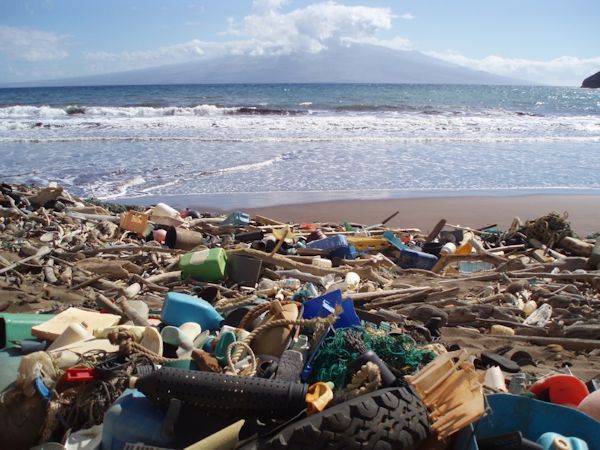SEJournal Online is the digital news magazine of the Society of Environmental Journalists. Learn more about SEJournal Online, including submission, subscription and advertising information.
 |
| Plastic detergent bottles, crates, buoys, combs and water bottles litter Kanapou Bay, on the Island of Kaho'olawe in Hawaii, a hot-spot for marine debris accumulation. Photo: National Oceanic and Atmospheric Administration. Click to enlarge. |
TipSheet: Ditching Plastic Straws — A Strawman for the Real Problem of Marine Litter?
The Starbucks declaration this summer that it will phase out plastic straws certainly put the story into the national headlines. And rush followed (although some others had gone before): Theme parks like Disneyland and SeaWorld; hotels like Hyatt, Hilton and Marriott; airlines like American Airlines; municipalities like Miami Beach, San Francisco, Berkeley and San Luis Obispo. New York City, Hawaii and California have straw-ban legislation pending.
You might notice a nautical theme here, and a tendency toward environmental liberalism. To be blunt about it, the straw-ban trend was in part stoked by one viral video of a sea turtle with a straw up its nose. It is painful to watch its removal.
And there was perhaps some inevitability to the Starbucks move, as the franchise originated in Seattle, the city where coffee was hip before it was hip, and Seattle itself had on July 1 slapped a citywide ban on plastic straws.
So in coming months, expect more companies and municipalities to ditch plastic straws. Perhaps it will be one near you, and if you are an environmental journalist, you may end up writing about it.
But here are some things to know before you file that story.
Banning straws may be a good thing. It is definitely a movement. And also news. This is certainly a story about values and also about optics.
Sorry to say it probably won’t save the planet or even the ocean.
Plastic marine waste goes well beyond straws
Overuse of plastics may be a bad thing. Stopping unnecessary straw use may be a good thing. But plastic straws up the noses of sea turtles may not be a widespread problem.
In fact, plastic straws may not be the biggest part of the ocean plastics problem.
Solid statistics about plastic straws, or plastic use and disposal generally, may be hard to find. For some, it’s enough that Neil deGrasse Tyson has ditched straws. Vox has made a serious effort to look into the numbers. So has National Geographic. Some scientists have tried to get a grip on it.
The main meme for many is keeping plastics out of the ocean, and scientist Jenna Jambeck has written a key article on this.
It is worth asking, though, how many of the plastic straws in the United States make it into landfills, how many are recycled and how many end up in the ocean.
Those questions may be even harder to answer on a global scale. There is evidence that the biggest share (86 percent, from rivers at least) of plastics going into the ocean comes from Asia.
Plastic straws remain focal point
Regardless, the plastic straw has become a battleground in the culture wars.
Witness a perhaps unintentionally satirical piece on NPR, positioning the straw ban as a dire threat to customers of San Francisco bubble-tea shops, who feel they are necessary to drink bubble tea.
Abstainers from plastic straws have turned to reusable metal straws, which are collapsible and cleanable. But Fox News crowed “Suckers Beware,” in a story about how one brand of metal straw was being counterfeited.
Skeptics of straw bans point out that some disabled people need them — but, in practice, many establishments can supply them on request (if the bans are not too inflexible).
It’s also worth remembering that humans have not always used plastic straws, and that paper straws (which can get soggy) used to be the norm. Paper straws have gotten better, are currently more expensive than plastic and have yet to become widely available.
Starbucks says its solution will be plastic “strawless lids” that work like adult sippy cups — not necessarily a reduction in plastic use, although at least it will not fit easily up a turtle’s nose.
And there really are occasions when (gasp) drinking straight out of a cup or glass is a workable alternative.
Resources to track the story
Some of the groups leading the charge against plastic straws include Surfrider Foundation, which campaigns against plastics in the ocean, albeit often through local chapter campaigns.
The Plastic Pollution Coalition has a spin-off called “The Last Plastic Straw.” A California group called Straw Free is very active. A more general group with global reach is Plastic Oceans.
One source for the plastics industry position on straws is the American Chemistry Council, the biggest chemical industry trade group. They say the solution is innovation in plastic packaging and support of consumer choice.
Your state or local restaurant or merchant’s association may well have a position too.
Another source is the Marine Debris Program at the National Oceanic and Atmospheric Administration.
* From the weekly news magazine SEJournal Online, Vol. 3, No. 31. Content from each new issue of SEJournal Online is available to the public via the SEJournal Online main page. Subscribe to the e-newsletter here. And see past issues of the SEJournal archived here.

















